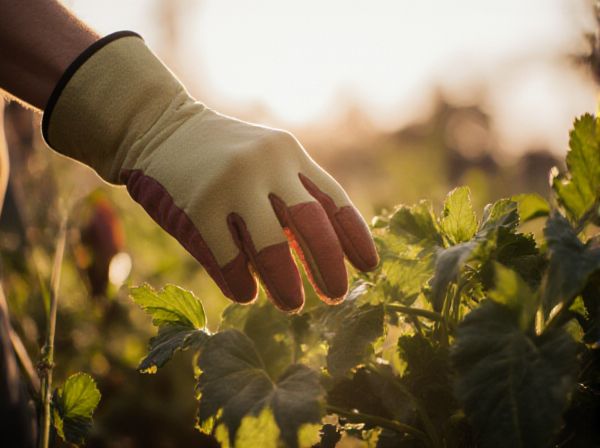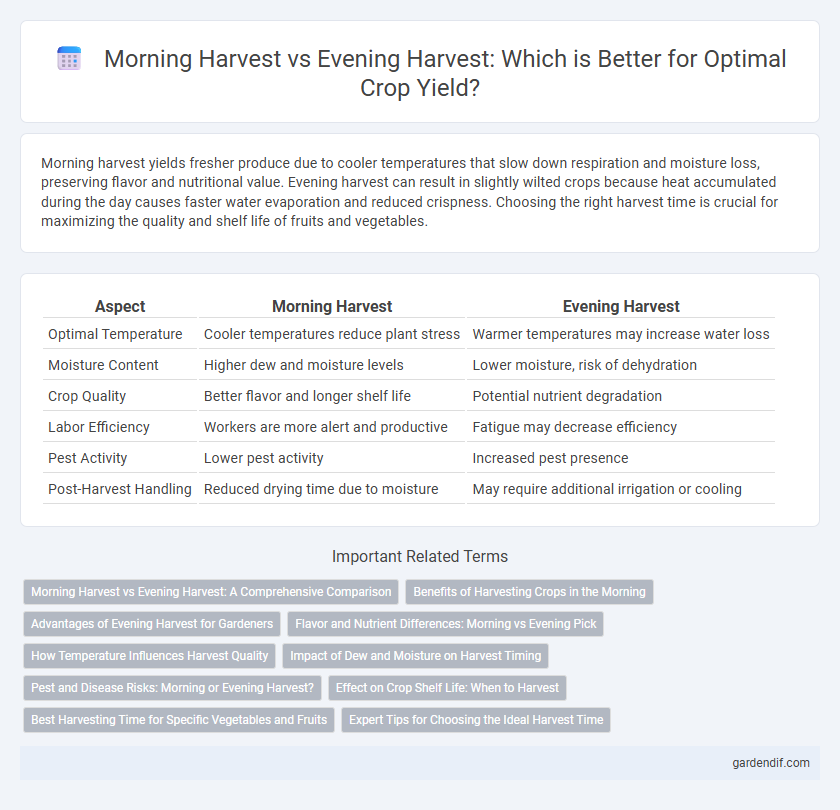
Morning harvest vs evening harvest Illustration
Morning harvest yields fresher produce due to cooler temperatures that slow down respiration and moisture loss, preserving flavor and nutritional value. Evening harvest can result in slightly wilted crops because heat accumulated during the day causes faster water evaporation and reduced crispness. Choosing the right harvest time is crucial for maximizing the quality and shelf life of fruits and vegetables.
Table of Comparison
| Aspect | Morning Harvest | Evening Harvest |
|---|---|---|
| Optimal Temperature | Cooler temperatures reduce plant stress | Warmer temperatures may increase water loss |
| Moisture Content | Higher dew and moisture levels | Lower moisture, risk of dehydration |
| Crop Quality | Better flavor and longer shelf life | Potential nutrient degradation |
| Labor Efficiency | Workers are more alert and productive | Fatigue may decrease efficiency |
| Pest Activity | Lower pest activity | Increased pest presence |
| Post-Harvest Handling | Reduced drying time due to moisture | May require additional irrigation or cooling |
Morning Harvest vs Evening Harvest: A Comprehensive Comparison
Morning harvest typically results in higher nutrient retention and better flavor profiles due to cooler temperatures that reduce plant respiration and moisture loss. Evening harvest, while convenient for some growers, often leads to increased wilting and diminished freshness because of the heat and prolonged exposure to sunlight during the day. Studies show that crops like leafy greens and herbs maintain optimal quality when picked early in the morning compared to late in the day.
Benefits of Harvesting Crops in the Morning
Harvesting crops in the morning maximizes moisture content retention, ensuring higher quality produce with longer shelf life. Cooler temperatures reduce plant stress and minimize nutrient loss, enhancing the freshness and nutritional value of fruits and vegetables. Morning harvest also limits exposure to pests and diseases, improving overall crop health and yield.
Advantages of Evening Harvest for Gardeners
Evening harvest offers gardeners the advantage of cooler temperatures, which helps preserve the freshness and flavor of fruits and vegetables by reducing water loss and wilting. Plants harvested in the evening also tend to retain higher nutrient levels, as metabolic activity slows down, preventing the rapid degradation of vitamins. Collecting crops in the evening minimizes plant stress and improves longevity during storage, making it an optimal time for maintaining quality post-harvest.
Flavor and Nutrient Differences: Morning vs Evening Pick
Morning harvest captures peak nutrient levels as plants have replenished sugars and antioxidants overnight, resulting in enhanced flavor and higher vitamin content. Evening harvest often yields produce with lower sugar concentration but increased moisture, which can impact texture and reduce shelf life. Choosing morning harvest optimizes taste and nutritional benefits, essential for fresh produce quality and consumer satisfaction.
How Temperature Influences Harvest Quality
Morning harvests benefit from cooler temperatures that help preserve the moisture content and reduce the risk of enzymatic degradation in crops, leading to enhanced freshness and extended shelf life. Evening harvests often face higher humidity and residual heat, which can accelerate spoilage and increase microbial growth, negatively impacting produce quality. Temperature fluctuations during harvest time critically influence the biochemical stability and overall post-harvest quality of fruits and vegetables.
Impact of Dew and Moisture on Harvest Timing
Dew and moisture significantly influence the timing of morning versus evening harvests, as crops harvested in the morning tend to have higher moisture content due to overnight dew accumulation, which can affect drying and storage quality. Evening harvests often benefit from drier conditions as plants lose moisture throughout the day, reducing the risk of fungal growth and spoilage during storage. Understanding the impact of dew presence is crucial for optimizing harvest timing to maintain crop quality and improve post-harvest handling efficiency.
Pest and Disease Risks: Morning or Evening Harvest?
Morning harvest typically reduces pest and disease risks due to lower humidity and cooler temperatures that inhibit pathogen growth and deter insect activity. Evening harvest can increase vulnerability to fungal infections and pest infestations as moisture levels rise and warmth persists, creating favorable conditions for spores and insects. Selecting morning hours for harvesting optimizes crop health and minimizes post-harvest losses caused by pests and diseases.
Effect on Crop Shelf Life: When to Harvest
Morning harvest preserves optimal moisture levels and cooler temperatures in crops, significantly extending shelf life by reducing post-harvest respiration rates. Evening harvests, often warmer and more humid, increase crop respiration and moisture loss, leading to faster spoilage. Choosing morning harvests enhances freshness and prolongs the marketability of fruits and vegetables.
Best Harvesting Time for Specific Vegetables and Fruits
Morning harvest preserves the optimal nutrient content and flavor in leafy greens, berries, and tomatoes due to cooler temperatures and higher hydration levels. Evening harvest suits root vegetables like carrots and potatoes because starches convert to sugars throughout the day, enhancing sweetness and texture. Selecting the best harvest time based on specific crops ensures maximum freshness, nutrient retention, and taste quality.
Expert Tips for Choosing the Ideal Harvest Time
Morning harvest captures peak nutrient levels and flavor intensity in fruits and vegetables due to cooler temperatures that reduce respiration and moisture loss. Evening harvest may be suitable for certain crops that accumulate sugars or specific phytochemicals later in the day, enhancing taste and shelf life. Experts recommend monitoring crop-specific metabolic patterns and local climate data to optimize harvest timing, ensuring maximum yield quality and post-harvest longevity.
Morning harvest vs evening harvest Infographic

 gardendif.com
gardendif.com